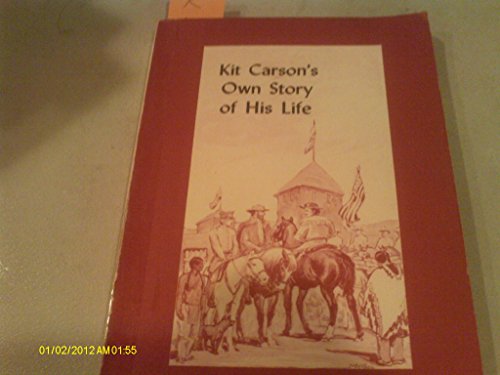kit carson editor blanche grant (3 résultats)
Type d'article
- Tous les types d'articles
- Livres (3)
- Magazines & Périodiques
- Bandes dessinées
- Partitions de musique
- Art, Affiches et Gravures
- Photographies
- Cartes
-
Manuscrits &
Papiers anciens
Etat
- Tous
- Neuf
- Ancien ou d'occasion
Reliure
- Toutes
- Couverture rigide
- Couverture souple
Particularités
- Edition originale
- Signé
- Jaquette
- Avec images
- Sans impression à la demande
Pays
Evaluation du vendeur
-
Kit Carson's Own Story of His Life: As Dictated to Col. and Mrs. D.C. Peters
Edité par The Narrative Press, 2001
ISBN 10 : 1589760603ISBN 13 : 9781589760608
Vendeur : Ergodebooks, Houston, TX, Etats-Unis
Livre
Paperback. Etat : Good.
-
Kit Carson's Own Story of His Life: As Dictated to Col. and Mrs. D. C. Peters about 1856-57, and Never Before Published
Edité par Taos, 1926
Vendeur : Clayton Fine Books, Shepherdstown, WV, Etats-Unis
Livre
Soft cover. Etat : Very Good. Very good in original wrappers with tape repairs at the spine extremities and reinforced hinges. Small date stamp on the copyright page.
-
Kit Carson's Own Story of his Life; As dictated to Col. and Mrs. D.C. Peters about 1856-57, and never before published
Edité par Kit Carson Memorial Foundation, Inc, Taos, N.M., 1955
Vendeur : Ground Zero Books, Ltd., Silver Spring, MD, Etats-Unis
Wraps. 138, [2] p. 24 cm. Illustrations, Portraits. Footnotes. Reprint of the Taos, N.M., 1926 ed. From Wikipedia: "Christopher Houston "Kit" Carson (December 24, 1809 May 23, 1868) was an American frontiersman and Indian fighter. Carson left home in rural present-day Missouri at age 16 and became a mountain man and trapper in the West. Carson explored the west to California, and north through the Rocky Mountains. He lived among and married into the Arapaho and Cheyenne tribes. He was hired by John C. Fremont as a guide, and led 'the Pathfinder' through much of California, Oregon and the Great Basin area. He achieved national fame through Fremont's accounts of his expeditions. He became the hero of many dime novels. Carson was a courier and scout during the Mexican-American war from 1846 to 1848, celebrated for his rescue mission after the Battle of San Pasqual and his coast-to-coast journey from California to deliver news of the war to the U.S. government in Washington, D.C. In the 1850s, he was the Agent to the Ute and Jicarilla Apaches. In the Civil War he led a regiment of mostly Hispanic volunteers at the Battle of Valverde in 1862. He led armies to pacify the Navajo, Mescalero Apache, and the Kiowa and Comanche Indians. He is vilified for his conquest of the Navajo and their forced transfer to Bosque Redondo where many of them died. Breveted a general, he is probably the only American to reach such a high military rank without being able to read or write, although he could sign his name. Kit Carson's alliterative name, adventurous life, and participation in a large number of historical events has made him a favorite subject of novelists, historians, and biographers.Carson's public image as a hero had been sealed by the Frémont expedition reports of 1845. In 1849 the first of many Carson action novels appeared. Written by Charles Averill, it bore the name Kit Carson: The Prince of the Gold Hunters. This type of western pulp fiction was known as blood and thunders. In Averill's novel, Carson finds a kidnapped girl and rescues her, after having vowed to her distraught parents in Boston that he would scour the American West until she was found. In November 1849, Carson and Major William Grier found the camp of the Jicarilla Apaches who had captured Mrs. Ann White and her daughter. The Jicarilla had attacked the White home and had killed her husband and others. Knowing the soldiers were near, the Jicarilla killed Mrs. White. While picking through the belongings that the Jicarilla had left in their camp, one of Major Grier's soldiers came across a book that the White family had carried with them from Missouri the paperback novel starring Kit Carson. This was the first time that Carson had come in contact with his own myth. The episode of the White family killings haunted Carson's memory for many years. He wrote in his autobiography: I have much regretted the failure of the attempt to save the life of so esteemed and respected a lady. In the camp was found a book, the first of the kind I had ever seen, in which I was made a great hero, slaying Indians by the hundred, and I have often thought that as Mrs. White would read the same and knowing that I lived near, she would pray for my appearance and that she might be saved. Later, when a friend offered Averill's book as a gift, Carson told the friend he would rather burn the damn thing. In fact, these extravagant novels set the public's view of Carson for a generation. Near the end of his life, Carson met a man from Arkansas. He recounted the incident later: I say, stranger, are you Kit Carson? the man asked. Carson said yes. Look ere, the Arkansan replied, casting his eye over Carson s diminutive frame. You ain t the kind of Kit Carson I m looking for. Following the March 30, 1854 battle of Cieneguilla, Lieutenant Colonel Philip St. George Cooke of the Second Regiment of Dragoons organized an expedition to pursue the Jicarilla. With the help of scouts led by Kit Carson, he caught and de.



